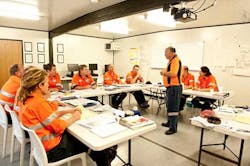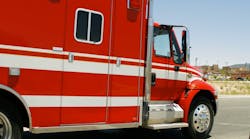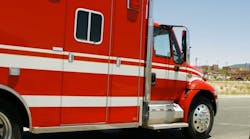Who does that guy work for?
Highly skilled tradespeople don’t often work under an temporary-employee agency’s umbrella, but moderate to low-skilled laborers can be brought in for tasks that don’t require trade-specific experience. Areas of the country that are experiencing labor shortages may find temporary workers to be a workable option. In some cases, a contractor may use temp labor to avoid costs such as employee benefits, union wages, or the price of vetting an employee’s experience or citizenship status.
Problems and hazards arise when the use of temp labor leads to assumptions as to who is liable for the temp’s safety training or who is responsible should a temp worker become injured or ill on the job site.
Here’s an example from OSHA:
Remediation and Construction, LLC (RAC) remediates damaged commercial and residential structures. They need additional skilled roofers to complete a commercial remediation project.
RAC contracts with Temp Staffing to provide unskilled laborers on a temporary basis to complete the job on time because unskilled laborers are less expensive than skilled roofers. Temp Staffing did not determine the type of work these workers would be doing and provided generic safety and health training for the workers before sending them to RAC’s work site.
At the work site, an RAC foreman assigned three of the temporary workers to work on the roof. For several days, the workers remove roofing material on top of a sheet metal roof of a fire-damaged building. The work location is approximately 13 feet above the ground. RAC did not mention to Temp Staffing that the temporary workers would be used as roofers and did not mention that the workers would need fall-protection training or any other job site-specific training. The temporary workers convey their concerns to the RAC foreman regarding the lack of fall protection and training while working on the fire-damaged roof. The foreman takes no action to provide fall protection or fall protection training.
The danger in this situation is magnified by the temp worker’s good intentions and efforts to show he’s a willing worker. Temp workers can be afraid to turn down a supervisor’s request because he fears the supervisor won’t ask him back for future work and the temp agency will put him at the bottom of their available list because he’s not productive enough in their estimation. The temp is weighing the cost of taking a chance with the real possibility of losing pay. Because the worker has had no experience and probably no safety training, his good work ethic may end up in an injury.
Who is responsible for his safety?
OSHA has released new guidance documents as part of their Temporary Worker Initiative (TWI), which focuses on safety and health compliance when workers are employed under a joint agreement between a staffing agency and a contractor. OSHA’s Safety and Health Training bulletin can be downloaded here.
OSHA says both the contractor (the host employer) and the temp agency are jointly responsible, and as such both can be cited and fined if a worker is injured or found to be working in unsafe conditions. Contractors will begin seeing more about this situation as OSHA’s new injury and illness recordkeeping requirements bring this issue into the spotlight.
OSHA says the staffing agency is responsible for providing generic safety and health training so that its workers have a basic ability to identify hazardous situations; report hazards, injuries and illnesses; and understand their rights if confronted with a hazardous situation at a work site. The staffing agency is also responsible for ensuring that employees receive proper site-specific training.
On a perfect job site, the staffing agency and contractor work together to make sure the temp worker has a safe place to work, understanding this requires effective initial and follow-up communication and a common understanding of the division of responsibilities for safety and health.
In real life, this partnership approach to temp worker safety can be tangled. The agency’s generic safety training is better than nothing at all, but that training isn’t site-specific. Although contractor-provided training is supposed to be monitored and ensured by the agency, there is nothing the agency can do to guarantee it.
OSHA inspectors are looking at this work site training arrangement in general terms and expects both the agency and the contractor to assume responsibility for the safety issues they are in the best position to control and address.
For example: The agency can provide general hazard communication (hazcom) training, but the host employer/contractor is the responsible party to train where the Safety Data Sheets (SDS) are kept on the jobsite, what hazardous materials the worker will be handling, and safety procedures in case of exposure or injury.
The same holds true for worker personal safety equipment. The agency will tell the worker to use fall-protection devices, but the contractor is in the best position to supply the gear and train on its use.
This subjective evaluation is part of how OSHA has directed its compliance officers to review any written contracts between the staffing agency and the host employer during inspections and determine if the employer-agency contract addresses responsibilities for employee safety and health.
Even if the agency has an on-site representative, responsibility for training is still the contractor’s responsibility and that responsibility does not transfer to the agency. However, failing to ensure that appropriate site-specific training was provided, Temp Staffing may also be subject to an OSHA citation related to fall protection training requirements.
What you can do
- Tailor your safety training procedures to the increases and decreases of labor on the job site. This means training supervisors to be aware of the dangers new and temp workers face on the job. An inexperienced worker may not tell anyone he’s having difficulty, but a good supervisor should notice the worker’s struggle and direct the worker to a task at which he is more competent.
- Training should include person-to-person discussions about your company’s written safety program that includes access and review of safety data sheets and signs, description of common task and equipment-specific hazards, and emergency contact information. Be aware of workers who may not be able to read written instruction due to language or learning limitations.
- Clearly specify injury-reporting procedures, locations, and responsible supervisors/competent persons. Make sure the worker reports an injury to your staff first.
- Encourage permanent employees to give a hand to and protect temp workers. Peer-to-peer safety discussions and suggestions can overcome a temp worker’s hesitancy to ask questions, and possibly avoid an injury.
- Regularly meet with the staffing agency to make sure its safety-training efforts are current and correct. Remember that staffing agencies also have a high turnover. Don’t assume they understand your job site hazards.





